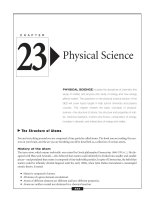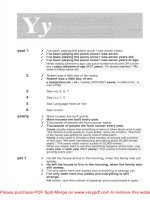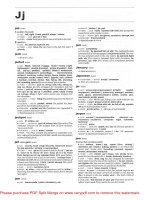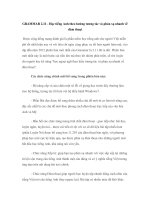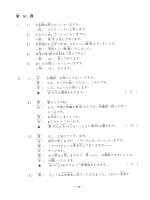2.11 Sound (physical science)
Bạn đang xem bản rút gọn của tài liệu. Xem và tải ngay bản đầy đủ của tài liệu tại đây (2.46 MB, 14 trang )
Physical Science
Genre
Nonfiction
Comprehension Skill
Important Details
Text Features
• Labels
• Glossary
Science Content
Sound
Scott Foresman Science 2.11
ISBN 0-328-13799-5
ì<(sk$m)=bdhj c< +^-Ä-U-Ä-U
by Ann J. Jacobs
Vocabulary
loudness
What did you learn?
Sound
1. How is sound made?
pitch
2. What is pitch?
by Ann J. Jacobs
vibrate
3.
Sound moves through
gases, liquids, and solids. In your own words
write to give an example of each. Use words
from the book as you write.
4.
Important Details Crickets make
sound. What are some important details
about how they do this?
Illustration: 23 Philip Williams
Photographs: Every effort has been made to secure permission and provide appropriate credit for
photographic material. The publisher deeply regrets any omission and pledges to correct errors called to its
attention in subsequent editions. Unless otherwise acknowledged, all photographs are the property of Scott
Foresman, a division of Pearson Education. Photo locators denoted as follows: Top (T), Center (C), Bottom
(B), Left (L), Right (R) Background (Bkgd)
Title Page: ©DK Images; 2 ©Thinkstock; 3 ©Thinkstock; 4 (T) ©Martin Harvey/NHPA Limited, (B) ©Jeff
Hunter/Getty Images; 5 (CC) ©George Hall/Corbis, (B) ©Walter Hodges/Corbis; 6 (T) ©The Image
Bank/Getty Images, (B) ©Photodisc Green/Getty Images; 7 (T, B)©Royalty-Free/Corbis; 8 ©Tom & Dee
Ann McCarthy/Corbis; 12 ©DK Images; 14 ©Taxi/Getty Images; 15 ©Mark Boulton/Photo Researchers,
Inc.; 16 Digital Vision; 17 ©Roger Wilmshurts/Frank Lane Picture Agency/Corbis; 19 ©Jeffrey L. Rotman/
Corbis; 20 (BL) ©Stephen Dalton/NHPA Limited, (R) ©DK Images, (CL) ©Stockbyte; 21 (TL) ©Royalty
Free/Corbis, (TC) ©Image Quest 3-D/NHPA Limited, (BC) Corbis, (BR) ©Brownie Harris/Corbis
ISBN: 0-328-13799-5
Copyright © Pearson Education, Inc.
All Rights Reserved. Printed in the United States of America. This publication is
protected by Copyright and permission should be obtained from the publisher prior
to any prohibited reproduction, storage in a retrieval system, or transmission in any
form by any means, electronic, mechanical, photocopying, recording, or likewise. For
information regarding permissions, write to: Permissions Department, Scott Foresman,
1900 East Lake Avenue, Glenview, Illinois 60025.
3 4 5 6 7 8 9 10 V010 13 12 11 10 09 08 07 06 05
What is sound?
Look at the band.
You can see lots of instruments.
Each one makes a sound when it is played.
2
Sound is made when something vibrates.
Vibrate means to move quickly back
and forth.
This flute makes the air vibrate, which
makes sound.
3
Loudness
You can use loudness to tell about a sound.
Loudness is how loud or soft a sound is.
4
How can you make a loud sound?
Bang on a drum!
What else makes a loud sound?
5
Some sounds are soft.
The leaves fall softly.
The kitten walks softly.
6
Tap a drum lightly.
It makes a soft sound.
What else makes soft sounds?
7
What is pitch?
Pitch means how high or low a sound is.
Things that vibrate fast have a high pitch.
Things that vibrate slowly have a low pitch.
8
Do you think this violin has a low or
high pitch?
It can have a high pitch when the strings
vibrate fast.
It can have a lower pitch when the strings
vibrate slowly.
9
Find out more about pitch.
Blow across the top of a bottle.
What happens to the air inside the bottle?
Lots of air,
low pitch
10
The air inside the bottle vibrates.
Bottles with a lot of air make a sound with
a low pitch.
Bottles with less air make a sound with
a high pitch.
Little air,
high pitch
11
Look at the bottles.
Which one makes the sound with the
highest pitch?
12
Which one makes the sound with the
lowest pitch?
13
Animals make many kinds of sounds.
Animal sounds can have a low or a
high pitch.
14
The bullfrog makes sounds with a low pitch.
This bird makes sounds with a high pitch.
15
How does sound travel?
Sound goes through solids, liquids,
and gases.
Sound moves fast through the air.
This bird pecks at a tree.
The sound moves through the tree and
the air.
This lion lets out a roar.
The sound goes through the air.
16
17
This dolphin clicks.
The sound moves through the water.
18
Sound moves faster through water than
through air.
Sound moves the fastest through solids,
such as wood.
19
How do some animals
make sounds?
Animals make sounds in lots of ways.
A cricket uses its wings.
It rubs them together.
The wings vibrate and make a sound.
The sound is like running your fingers
on the teeth of a comb.
A rattlesnake shakes its tail.
Its tail works like maracas.
A lobster makes sounds.
It rubs its antenna on the side of its head.
Its antenna works like a violin.
20
21
What are some sounds
around you?
There are sounds all around.
You might hear a fire truck.
You might hear children.
You might hear a fly.
Every day we hear sounds.
Just listen!
22
23
Vocabulary
Glossary
What did you learn?
loudness
loudness
1. How is sound made?
pitch
pitch
vibrate
vibrate
how loud or soft a sound is
how high or low a sound is
to move quickly back and forth
Illustration: 23 Philip Williams
Photographs: Every effort has been made to secure permission and provide appropriate credit for
photographic material. The publisher deeply regrets any omission and pledges to correct errors called to its
attention in subsequent editions. Unless otherwise acknowledged, all photographs are the property of Scott
Foresman, a division of Pearson Education. Photo locators denoted as follows: Top (T), Center (C), Bottom
(B), Left (L), Right (R) Background (Bkgd)
Title Page: ©DK Images; 2 ©Thinkstock; 3 ©Thinkstock; 4 (T) ©Martin Harvey/NHPA Limited, (B) ©Jeff
Hunter/Getty Images; 5 (CC) ©George Hall/Corbis, (B) ©Walter Hodges/Corbis; 6 (T) ©The Image
Bank/Getty Images, (B) ©Photodisc Green/Getty Images; 7 (T, B)©Royalty-Free/Corbis; 8 ©Tom & Dee
Ann McCarthy/Corbis; 12 ©DK Images; 14 ©Taxi/Getty Images; 15 ©Mark Boulton/Photo Researchers,
Inc.; 16 Digital Vision; 17 ©Roger Wilmshurts/Frank Lane Picture Agency/Corbis; 19 ©Jeffrey L. Rotman/
Corbis; 20 (BL) ©Stephen Dalton/NHPA Limited, (R) ©DK Images, (CL) ©Stockbyte; 21 (TL) ©Royalty
Free/Corbis, (TC) ©Image Quest 3-D/NHPA Limited, (BC) Corbis, (BR) ©Brownie Harris/Corbis
ISBN: 0-328-13799-5
Copyright © Pearson Education, Inc.
All Rights Reserved. Printed in the United States of America. This publication is
protected by Copyright and permission should be obtained from the publisher prior
to any prohibited reproduction, storage in a retrieval system, or transmission in any
form by any means, electronic, mechanical, photocopying, recording, or likewise. For
information regarding permissions, write to: Permissions Department, Scott Foresman,
1900 East Lake Avenue, Glenview, Illinois 60025.
3 4 5 6 7 8 9 10 V010 13 12 11 10 09 08 07 06 05
24
2. What is pitch?
3.
Sound moves through
gases, liquids, and solids. In your own words
write to give an example of each. Use words
from the book as you write.
4.
Important Details Crickets make
sound. What are some important details
about how they do this?
